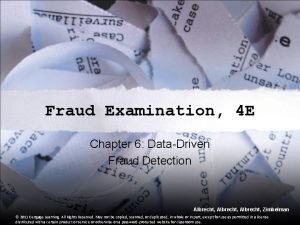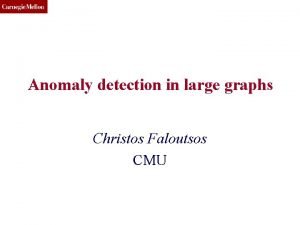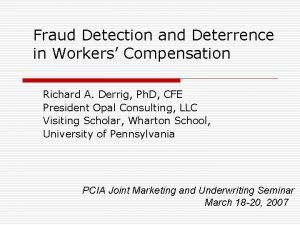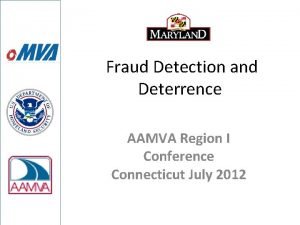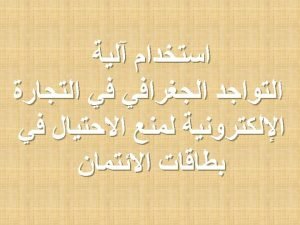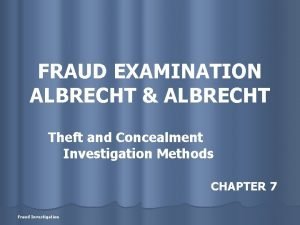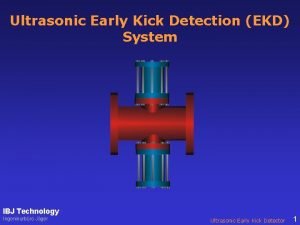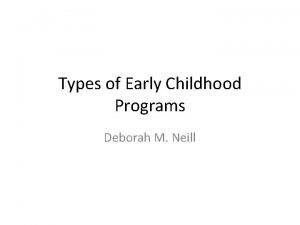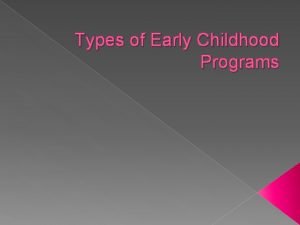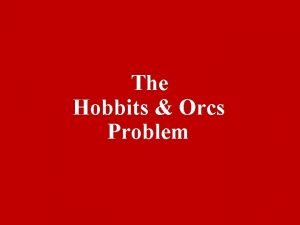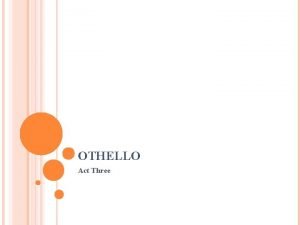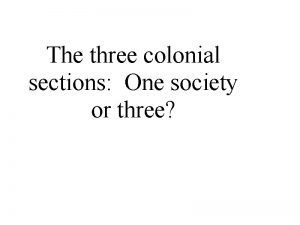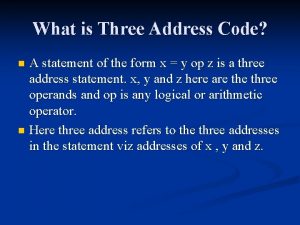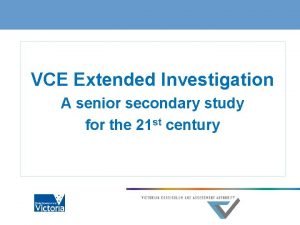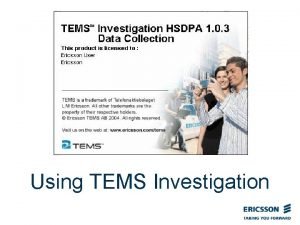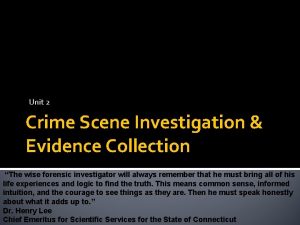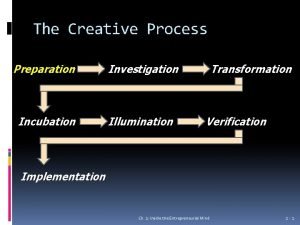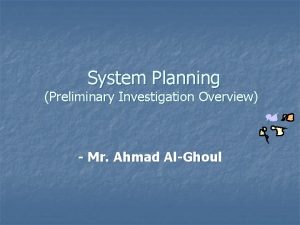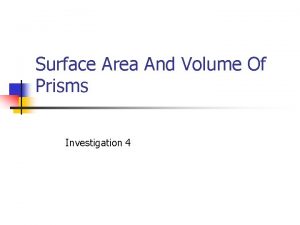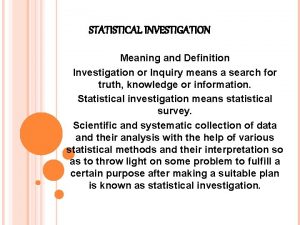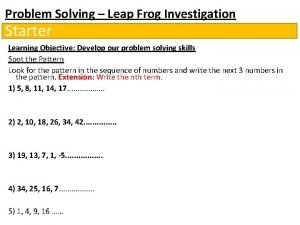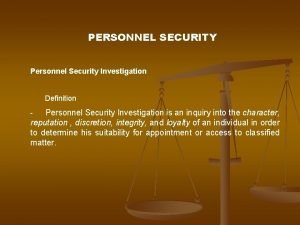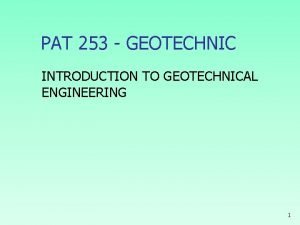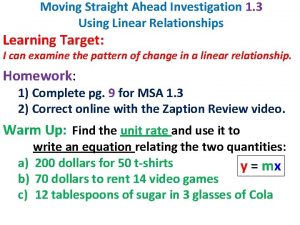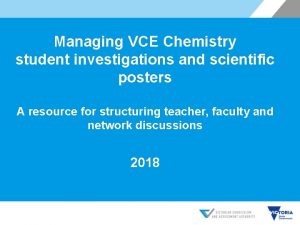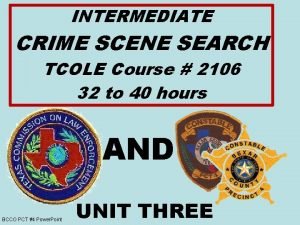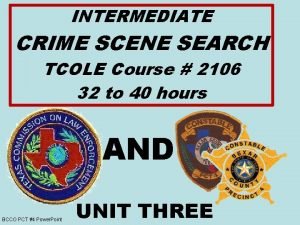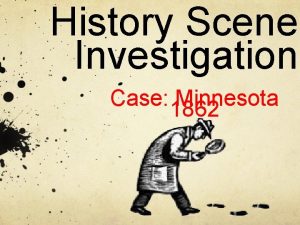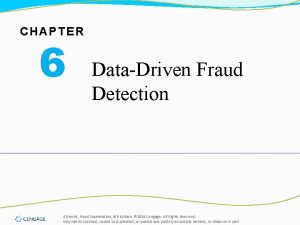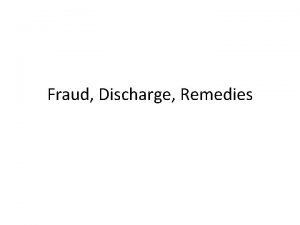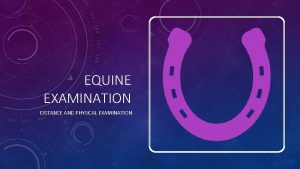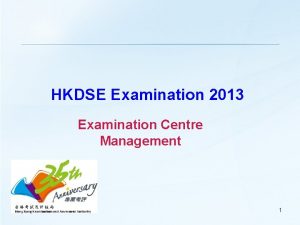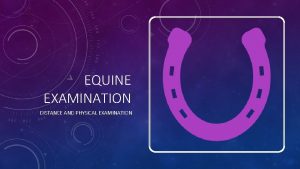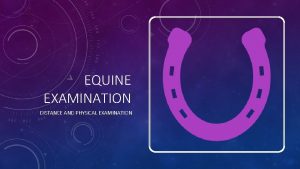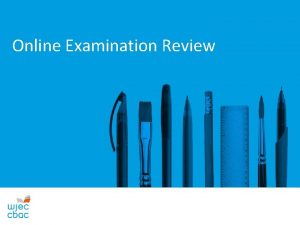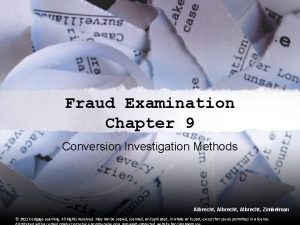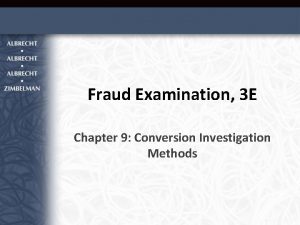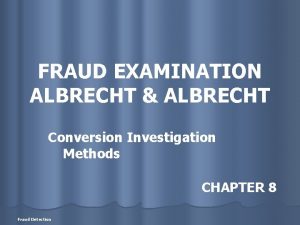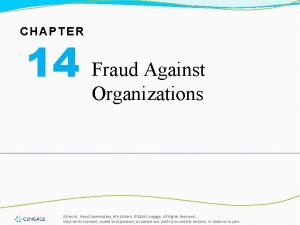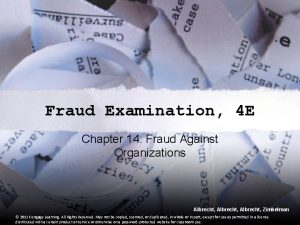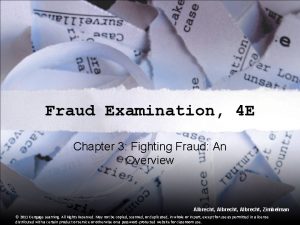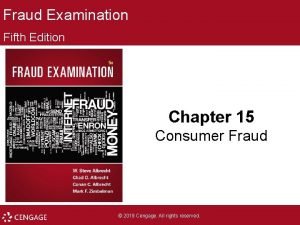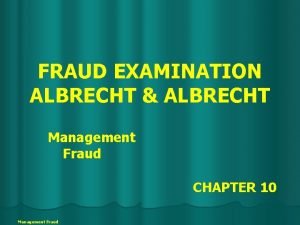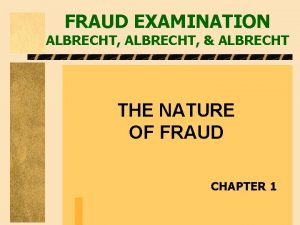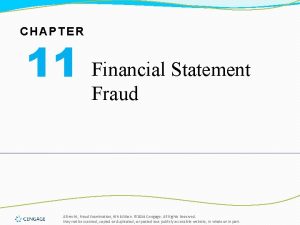Fraud Investigation Fraud Examination Early Fraud Detection Three




































- Slides: 36

Fraud Investigation Fraud Examination

Early Fraud Detection Three Primary Ways to Detect Fraud 1. By chance 2. By providing “whistleblowing” systems 3. By data mining

The CFE gathers evidence of the ELEMENTS of Fraud Conversion Elements Of Fraud Concealment Accounting 537 Theft

Early Fraud Detection § Mining Company Databases § Mining databases for suspicious trends, numbers, and other anomalies. § Whistle-blowing Systems § A reporting hotline or online system that allows others to call in or submit an anonymous tip of a fraud suspicion § Examples: § Internal systems/hotlines § The Association of Certified Fraud Examiners § Allegience

When would we actually begin a Fraud Examination? When there is PREDICATION of fraud “Circumstances, Taken as a Whole, that Leads a Reasonable Prudent Professional to Believe a Fraud is Occurring, or Has Occurred, or Will Occur” Accounting 537

What Are the Considerations in Deciding to Investigate? 1. 2. 3. 4. 5. 6. 7. Perceived strength of the predication Perceived cost of the investigation Exposure or amount that could have been taken Signal that investigating or not investigating will send to others in the organization Risks of investigating or not investigating Public exposure or loss of reputation from investigating or not investigating Nature of the possible fraud Accounting 537

Interview Suspect

The CFE’s Evidence Square Testimonial Evidence 2 Documentary Evidence 1 4 Physical Evidence Personal Observation 3 Accounting 537

The CFE’s Evidence Square Testimonial 1 Gathered from Individuals, Includes Interviewing, Interrogation & Honesty Tests Gathered from Papers, Computers & Written & Printed Sources Fingerprints, Weapons, Stolen Property Often Involves Forensic Analysis Physical 2 Documentary Personal Observation 4 Collected by the Investigator, includes Invigilation, Surveillance and Operations Accounting. Covert 537 3

Fraud Investigation § Testimonial Evidence § Evidence gathered from individuals § Techniques: § Interviewing § Interrogation § Honesty tests

Fraud Investigation § Documentary Evidence § Gathered from paper, computers, and other written or printed sources § Techniques: § § § § § Document examination Data mining Public records searches Audits Computer searches Net worth calculations Financial statement analysis Corporate databases E-mail servers

Fraud Investigation § Physical Evidence § Fingerprints § Tire marks § Weapons § Stolen property § Identification numbers § Marks on stolen objects § Other tangible evidence § Techniques: § Forensic analysis by experts

Fraud Investigation § Personal Observation § Evidence that is sensed (seen, heard, felt, etc. ) by the investigators § Techniques: § Invigilation § Surveillance § Covert operations

Evidence Gathering § Surveillance & Undercover Operations § Invigilation § Physical Evidence § Documents – paper and electronic § Chain of custody rules § Access – subpoena, search warrant, voluntary § Forgery or alteration Accounting 537

Sources of Information Public Records Government • Federal • State • Local Private Sources • Utility Records • Previous Acquaintances • Trash Cover • Credit Agencies • Financial Institutions Online Databases • Subscription • Per-Search Fee Free Accounting 537 Internet Searches • Google • Altavista • Etc.

Income Reconstruction Methods § Direct Method § Calculating income from information obtained in books and records, usually looking for unreported income § Examples: non reported sales or transfers of real estate, cars, or insured items, and non reported transactions represented by invoices § Indirect Method § This is to be used when the books are not adequate, or unavailable.

Indirect Methods of Reconstructing Income § Net Worth Method § Sources and Applications of Funds § Percentage Markup Method § Bank Deposit Method § Unit Volume Computation

Net Worth Calculation 1. Assets – Liabilities = Net Worth 2. Net Worth – Prior Year’s Net Worth = Net Worth Increase 3. Net Worth Increase + Living Expenses = Income 4. Income – Funds from Known Sources = Funds from Unknown Sources Accounting 537

How can information be obtained from a source 1. Pencil & Paper Test 2. Graphology 3. Voice Stress Analysis & Polygraphs Accounting 537

Interviewing § Most Common Technique § Question & Answer Format § Structured Has a Purpose § Low Cost § Effective if Done Well Accounting 537

Accounting 537

Fraud Investigation Fraud Examination

Fraud Investigation § The Fraud Element Triangle: Theft Act § Catch perpetrators in the embezzlement act or to gather information about the actual theft acts § The Fraud Element Triangle: Concealment § Focus on records, documents, computer programs and servers, and other places where perpetrators conceal or hide their dishonest acts

Fraud Investigation § The Fraud Element Triangle: Conversion § Search for ways the perpetrators spent or used their stolen assets.

Conducting a Fraud Investigation 1. Undertaken only to “establish the truth” 2. Experienced and objective investigators 3. Confidentiality 4. Need to know 5. Evidence independently corroborated 6. No questionable investigative techniques

Interviews Obtain 1. Information that Establishes Essential Elements of the Crime 2. Leads for Developing the Case or Gathering Other Evidence 3. Cooperation of Witnesses & Victims 4. Information on Personal Background & Motives of Witnesses Accounting 537

What information do you need to plan the interview? § § § About The Offense About The Interviewee Legal Nature § Personal Background Date, Time, Place § Age Manner in which Crime § Education was Committed § Marital Status Possible Motives § Attitude Toward All Available Evidence Investigation Accounting 537

Interviewer’s Demeanor § Sit Fairly Close, Stay Seated § Don’t Talk Down § Be Sensitive & Business Like § Do Not Dominate Interview § Do Not Use Jargon § Do Not Use Paper & Pencil, Keep Out of Sight § Express Sincere Appreciation Accounting 537

Interview Language § Short Questions, Stay on One Topic § Seek Narrative Answers § No Leading Questions § Get the Facts for Opinions § Keep Interviewees on Track § Stay on Topic § Concentrate on Answers Accounting 537

List 5 Types of Questions 1. 2. 3. 4. 5. Introductory Information Closing Assessment Admission Seeking Accounting 537

What is the reaction sequence? 1. Denial – Acts as a psychological buffer, 2. 3. 4. 5. subject doesn’t acknowledge stress Anger – All directions, result of frustration Rationalization or Bargaining – Justify dishonest actions, “A mistake was made. ” Depression – Sad and withdrawn Acceptance – Realistic understanding of what happened, resolve & move on, best time for interviews Accounting 537

Why is the reaction sequence important to a fraud examiner? The suspect may go through this sequence in the course of an interview. Other people in the organization may go through this sequence in the course of the investigation. Being aware of these emotional stages will help the fraud examiner to identify them and take the more productive actions. Accounting 537

End Fraud Investigation Fraud Examination

Discuss Pencil & Paper Tests § Honesty cs i h t E of e d o C § Codes of Ethics § 50% to 90% Accurate § Easy to Tabulate Accounting 537

Graphology þThe study of handwriting for the purpose of character analysis. Increased Utilization Banking, Manufacturing & Insurance Fraud Examiners Skeptical Accounting 537

Voice Stress Analysis & Polygraphs § Used to Determine If Someone Is Telling the Truth Or Lying § Pulse, Blood Pressure, Respiration, etc. § Frightens Innocent People § Not Effective for Psychopathic Liars § Voluntary § Administration Affects the Quality of Results Accepted Accounting 537
 Data driven fraud detection
Data driven fraud detection Fraud detection
Fraud detection Workers compensation fraud detection
Workers compensation fraud detection Aamva conference
Aamva conference Sequence diagram for credit card fraud detection
Sequence diagram for credit card fraud detection Fraud examination albrecht
Fraud examination albrecht How do fraud symptoms help in detecting fraud
How do fraud symptoms help in detecting fraud Early kick detection
Early kick detection National breast and cervical cancer early detection program
National breast and cervical cancer early detection program National breast and cervical cancer early detection program
National breast and cervical cancer early detection program Early cpr and early defibrillation can: *
Early cpr and early defibrillation can: * Types of early childhood programs
Types of early childhood programs Italian high renaissance art
Italian high renaissance art Three types of early childhood programs
Three types of early childhood programs Orc and hobbit problem
Orc and hobbit problem Othello act three scene three
Othello act three scene three In three minutes write
In three minutes write Regulatory signs examples
Regulatory signs examples The three colonial sections-one society or three
The three colonial sections-one society or three Three address code examples
Three address code examples Extended investigation vce
Extended investigation vce How to use tems investigation
How to use tems investigation What are the seven s's of crime scene investigation
What are the seven s's of crime scene investigation Illumination in entrepreneurship
Illumination in entrepreneurship System planning and initial investigation
System planning and initial investigation Surface area investigation
Surface area investigation Statistics investigation
Statistics investigation Special right triangle investigation
Special right triangle investigation Leapfrog investigation
Leapfrog investigation Security personnel definition
Security personnel definition Spacing of boreholes for soil investigation
Spacing of boreholes for soil investigation Moving straight ahead investigation 1
Moving straight ahead investigation 1 Vce chemistry practical investigation
Vce chemistry practical investigation Intermediate crime scene search #2106
Intermediate crime scene search #2106 Tcole intermediate crime scene
Tcole intermediate crime scene Historical scene investigation
Historical scene investigation Whitewater apush
Whitewater apush
